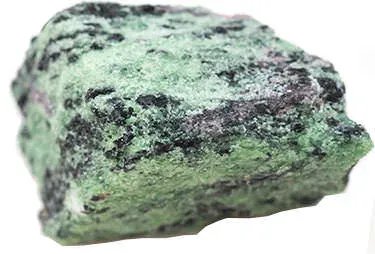 Zoisite has been known for nearly two centuries as an ornamental stone. The stone was named after the Austrian scientist Sigmund Von Zois, who discovered it in the Saualpe Mountains of Carinth, Austria. Zoisite comes in a variety of colors such as gray, pink, lavender, pale-green or brown.
Zoisite has been known for nearly two centuries as an ornamental stone. The stone was named after the Austrian scientist Sigmund Von Zois, who discovered it in the Saualpe Mountains of Carinth, Austria. Zoisite comes in a variety of colors such as gray, pink, lavender, pale-green or brown.
 The stones are usually heat treated to enhance their color. Lavender-blue zoisite is called tanzanite and is the most sought after variety of the stone. Pink zoisite is called thulite, which is colored by manganese. The green variety of zoisite is sometimes called green zoisite, green tanzanite, or chrome tanzanite. The green stones can be slightly yellowish green to gray green to bluish green, and their color is natural.
The stones are usually heat treated to enhance their color. Lavender-blue zoisite is called tanzanite and is the most sought after variety of the stone. Pink zoisite is called thulite, which is colored by manganese. The green variety of zoisite is sometimes called green zoisite, green tanzanite, or chrome tanzanite. The green stones can be slightly yellowish green to gray green to bluish green, and their color is natural.
 There is also quite an extraordinary variety of zoisite called
There is also quite an extraordinary variety of zoisite called ![]() ruby zoisite. This is an ornamental material consisting of crystalline aggregates of green zoisite with non-transparent ruby inclusions. There isn't another stone like it in the mineral world.ï¾ The green zoisite is relatively soft, rating between a 5.5 - 6.5 on the hardness scale, while the ruby inclusions are usually quite hard, around a 9 on the Moh's scale. The medium grade red ruby material is usually spread irregularly throughout the green zoisite. Ruby zoisite is quite a beautiful sight. Other forms of zoisite rate a 6 on the hardness scale. They can be transparent to sub translucent, and are brittle and vitreous.
ruby zoisite. This is an ornamental material consisting of crystalline aggregates of green zoisite with non-transparent ruby inclusions. There isn't another stone like it in the mineral world.ï¾ The green zoisite is relatively soft, rating between a 5.5 - 6.5 on the hardness scale, while the ruby inclusions are usually quite hard, around a 9 on the Moh's scale. The medium grade red ruby material is usually spread irregularly throughout the green zoisite. Ruby zoisite is quite a beautiful sight. Other forms of zoisite rate a 6 on the hardness scale. They can be transparent to sub translucent, and are brittle and vitreous.
 Zoisite has many positive attributes to bring into our lives. It represents joy and discovery and has the power to lead us to the adventures of self-discovery. It has been said to make us conscious of aspects of our strength that come from our childhood. With this knowledge, we can gain even more strength and confidence as we integrate this into our adult lives. Overall, zoisite is believed to be a stone that can help us to be more strong, joyous and whole. It has been said to transmute negative energies into positive ones, assisting us in manifesting our own self rather than conforming to the norm. The stone aids in realizing our ideas and transforming destructive urges into constructive ones. It also has the power to dispel lethargy, encourages recovery from severe illness or stress, and detoxifies the body. It also strengthens the immune system, regenerates cells, and treats the heart, spleen, pancreas, and lungs.
Zoisite has many positive attributes to bring into our lives. It represents joy and discovery and has the power to lead us to the adventures of self-discovery. It has been said to make us conscious of aspects of our strength that come from our childhood. With this knowledge, we can gain even more strength and confidence as we integrate this into our adult lives. Overall, zoisite is believed to be a stone that can help us to be more strong, joyous and whole. It has been said to transmute negative energies into positive ones, assisting us in manifesting our own self rather than conforming to the norm. The stone aids in realizing our ideas and transforming destructive urges into constructive ones. It also has the power to dispel lethargy, encourages recovery from severe illness or stress, and detoxifies the body. It also strengthens the immune system, regenerates cells, and treats the heart, spleen, pancreas, and lungs.
 Zoisite occurs in schists and gneisses, and in metamorphic rocks, together with
Zoisite occurs in schists and gneisses, and in metamorphic rocks, together with ![]() garnet, actinolite, and vesuvianite. Thulite is usually found in Norway, Austria, Western Australia, Italy and the USA. The green, yellow, and grayish-green varieties come from California, Tanzania and Kenya. Other varieties of zoisite can be found in Sweden, New Hampshire, Northern Pakistan, and South Africa.
garnet, actinolite, and vesuvianite. Thulite is usually found in Norway, Austria, Western Australia, Italy and the USA. The green, yellow, and grayish-green varieties come from California, Tanzania and Kenya. Other varieties of zoisite can be found in Sweden, New Hampshire, Northern Pakistan, and South Africa.
 Zoisite is a fairly brittle stone; therefore it can chip easily and should be worn with care. Avoid sharp blows or scratches. The green variety of zoisite is actually less fragile than other varieties as it is not heated, which can cause brittleness. Never clean zoisite with ultrasonic cleaners. Instead, use warm soapy water and dry the stone with a soft cloth afterwards. Keep your zoisite away from any contact with acids.
Zoisite is a fairly brittle stone; therefore it can chip easily and should be worn with care. Avoid sharp blows or scratches. The green variety of zoisite is actually less fragile than other varieties as it is not heated, which can cause brittleness. Never clean zoisite with ultrasonic cleaners. Instead, use warm soapy water and dry the stone with a soft cloth afterwards. Keep your zoisite away from any contact with acids.